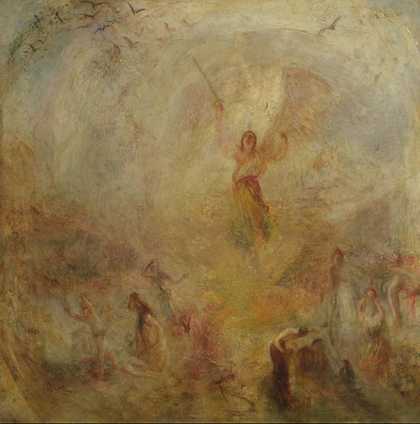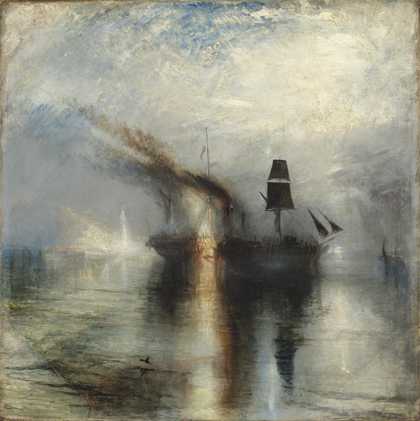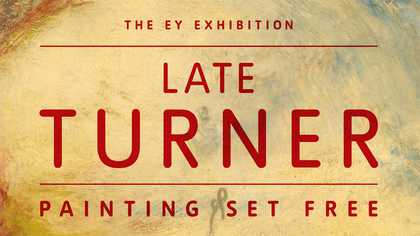But this was a time of critical warfare, when Turner was at the receiving end of vicious attacks, but also won the admiration of the greatest critic of the age, John Ruskin
Shards, gherkins, giant porcupines – we are used to such similes for modern buildings. In their day, Turner’s pictures were dubbed – far less affectionately – brimstone, brick dust, spinach and eggs, fish kettles, omelettes and ‘the whole array of kitchen stuff’, not to mention ‘trumpery conceits’ and ‘freaks of chromomania’. His most radical and experimental late works, in which he distilled effects of colour and light in ways that have since been seen as forerunners of impressionism or abstraction, were never exhibited, maybe unfinished, and were not available to critics at all. But even those that were shown in public attracted some of the most lurid and insulting art reviews ever written. In turn, they provoked a more serious, initially sympathetic but in its way equally prejudiced critique. However distorted or discredited, these responses are a lens through which we can see just how disturbing Turner’s pictures were when they first appeared.
They are also a reflection on the stunted critical standards of the time. Genuinely informed and sensitive commentators on art, such as the engraver-painter John Landseer or, until his death in 1830, William Hazlitt, a literary heavyweight who had tried to paint, were rare exceptions. Landseer’s short-lived Review of Publications of Art (c1808) and his journal The Probe (1839–40) published his own intelligent evaluations of Turner. Hazlitt, while not uncritical, admired the painter’s luminous atmospherics. He certainly did not deserve his friend Benjamin Haydon’s jibe that his failure as an artist resulted in his ‘damping the ardour, chilling the hopes, and damning the prospects of others’. Fascinated by artists in their old age, Hazlitt sadly did not live long enough to witness Turner’s late creative flowering or give final judgment on the question pondered by so many others: whether he had nurtured or squandered his genius.
There may have been few professional critics and little idea of what qualified a person for the role, but there was nevertheless a wide spectrum of newspapers and journals that carried stories on art and had editors who commissioned them: John Scott of The Champion – until killed in a duel in 1821; Thomas Barnes of The Times; James Elmes whose Annals of the Fine Arts was often a mouthpiece for Haydon (a failure himself) and consequently dubbed by another journalist, William Carey, the ‘Liber Falsitatis’; Leigh and Robert Hunt of the radical Examiner; RS Rintoul of The Spectator from 1828; and SC Hall of the Art Union from 1839, to name only a few. The quality, experience and opinions of their contributors varied enormously, and they often appeared under cover of anonymity or pseudonym. Abrasive wit can be a clue to the authorship of Edward Dubois, whose day job as a lawyer warned him just how far he could go until he overstepped the mark and fell silent in 1834. Meanwhile, Thomas Griffiths Wainewright, forger and serial poisoner as well as journalist, wrote as ‘Janus Weathercock’ and ‘Egomet Bonmot’, WH Pyne as ‘Ephraim Hardcastle’, John Williams as ‘Anthony Pasquin’ and the novelist Thackeray as ‘Michael Angelo Titmarsh’.
Behind such ‘names’ hid a swarm of unidentified hacks who wrote guides to exhibitions, highly colourful descriptions of pictures and malicious gossip. Literary vultures paid by the word, they pecked over anything or anyone unusual or strange, stirring up outrage and argument. Such an original painter as Turner was fair game, and it is difficult to resist the conclusion that the artist and his critics existed in a symbiotic relationship, the latter thriving on the provocations his pictures so reliably provided. Consensus could hardly be expected, and as the Library of Fine Arts wrote (anonymously) in 1832, Turner aroused ‘the unfeigned delight of one half of the world… and … self-conceited supercilious remarks of the other’. Poles of opinion sometimes coexisted. Within a single year (1839–40) the Art Union described him as ‘the greatest of the age’ and a ‘madman’ who ‘says wonderful things between fits’. It was referring to his art, but in 1845 the editor Hall listed all the personal qualities the painter lacked to become president of the Royal Academy, including education, manners and liberal feelings.

Joseph Mallord William Turner
The Angel Standing in the Sun (exhibited 1846)
Tate
With friends like these, Turner hardly needed enemies. But happy to fill the role was the Rev John Eagles, an occasional painter and poet who began reviewing art in the Tory Blackwood’s Magazine in 1835, disguised as ‘The Sketcher’. Allergic to anything he thought pretentious, and alighting on the artist’s reference to Byron’s poem Childe Harold’s Pilgrimage in the full title of The Bright-Stone of Honour (Ehrenbreitstein) and Tomb of Marceau, from Byron’s ‘Childe Harold’, exhibited in 1835, he found ‘no more poetry than the paring of a toe nail.’ The following year, Turner’s inclusion of Shakespeare’s Juliet, who belonged in Verona, in a picture of Venice so infuriated the pedantic Eagles that John Ruskin, then a youth of 17, was moved to defend the painter. He sent Turner a draft response, describing him as an exceptional artist who should not be judged by normal standards. Turner advised against interfering in mere ‘mischief’, but for Ruskin, the seed was sown for a lifetime’s collecting and interpretation of the painter’s work, beginning with his great polemic Modern Painters, published (anonymously at first) from 1843.

Joseph Mallord William Turner
Peace - Burial at Sea (exhibited 1842)
Tate
In Ruskin’s view, Turner’s ‘modernity’ lay in his mastery as a painter of nature. Compelling as this argument was, it excluded not only the artist’s historical pictures, which the critic dismissed as ‘preposterous accumulations’, but depictions of man-made modernity such as steam power. Ruskin sidestepped Rain, Steam and Speed 1844 and wrote off Cicero at his Villa, exhibited in 1839, as ‘nonsense’. His bias was arguably more damaging for being presented as objective analysis and less easily discounted than Eagles’s obviously absurdist description of Cicero as ‘scratched in with old broken combs’ with figures like ‘vitrified tadpoles’. While Eagles airily invoked a collective ‘public taste’ that Turner’s pictures were a ‘bold attempt to insult’, Ruskin set out to mould and reform taste according to his own, and, as he told the artist Samuel Prout, to refute the ‘paid novices’ of Blackwood’s and The Times. Ruskin was bolstered by independent wealth and could no more hope to stem the causes than change the content of popular journalism. It is the more regrettable, then, that at times he came close to sharing its prejudices or being persuaded by the cruellest and most personal claims of Turner’s critics – that the artist had lost his faculties and become a travesty of his former self. There seems little to divide the unnamed Athenaeum journalist who saw a ‘diseased eye and reckless hand’ in 1841’s Dawn of Christianity from Ruskin judging 1846’s Angel Standing in the Sun ‘indicative of mental disease’. Clearly neither writer was remotely equipped (even if they tried) to engage with such pictures on Turner’s own terms.

